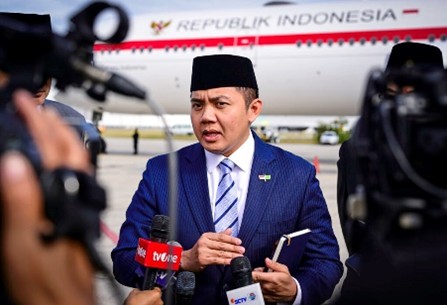BMKG Warns of Potential Extreme Weather on 10-16 February 2021, Urges People to Remain Vigilant

Source: PR of BMKG
The Meteorology, Climatology, and Geophysics Agency (BMKG) has warned of potential extreme weather between 10 until 16 February 2021.
The agency also reported that most of regions in Indonesia (96 percent of 342 seasonal zones) have entered rainy season.
Since August last year, the agency has also forecast that the peak of rainy season would occur in January – February 2021 in southern parts of the island of Sumatra, most of the island of Java, including Special Capital Region of Jakarta, parts of the island of Kalimantan, the island of Bali, Nusa Tenggara, parts of the islands of Sulawesi, parts of Maluku province, most of West Papua province, and the southern part of Papua island.
“Based on that condition, we have to remain vigilant of potential extreme weather,” said BMKG Deputy for Meteorology Guswanto in a written statement, Tuesday (02/09/2021).
BMKG’s analysis also shows that the condition of unstable atmospheric dynamics in the next few days can increase the potential for rain cloud growth in some regions in the country.
In addition, strong atmospheric instability in some regions in Indonesia can also affect the growth of rain clouds significantly on a local scale.
Therefore, the agency predicted that in the next week there will be high-intensity rainfall with potential lightning and strong winds in the provinces of Aceh, North Sumatra, West Sumatra, Jambi, Bengkulu, South Sumatra, and Lampung.
The same weather may also occur in the provinces of Banten, West Java, Central Java, Special Region of Yogyakarta, East Java, Bali, West Nusa Tenggara (NTB), East Nusa Tenggara (NTT), Central Kalimantan, South Kalimantan, East Kalimantan. Eastern parts of Indonesia, including Central Sulawesi, South Sulawesi, Southeast Sulawesi, North Maluku, Maluku, West Papua, and Papua, were predicted to have this extreme weather as well.
Due to the result of Impact Based Forecast (IBF) for potential floods/flashfloods on 10-11 February 2021, the provinces of Banten, West Java, Central Java, and East Java have been put on siaga (watch) status, which is the second-highest level of Indonesia’s four-level alert system.
Meanwhile, based on the integrated analysis of data from BMKG, Ministry of Public Works and Housing, and Geospatial Information Agency, moderate floods are predicted to occur on 11-20 February 2021 in small parts of southern Aceh, small parts of central Jambi, small parts of eastern West Java, northern parts of Central Java, small parts of eastern East Java, small parts of southern Central Sulawesi, northern Southeast Sulawesi, small parts of eastern West Papua, and small parts of northern and central Papua.
Furthermore, the growth of cumulonimbus clouds with a maximum spatial coverage between 50 and 75 percent (OCNL/Occasional) is expected on 8-14 February 2021 in the provinces of Bengkulu, Lampung, South Sumatra, Bangka Belitung Islands, Banten, Special Capital Region of Jakarta, West Java, Central Java, East Java, Bali, NTB, NTT, North Kalimantan, East Kalimantan, Central Sulawesi, Southeast Sulawesi, parts of West Papua, parts of Papua, western waters of Bengkulu, Java Sea, Indian Ocean south of Java, Makassar Strait, Banda Sea, and Arafuru Sea.
In the meantime, moderate tides of 1.25-2.5 meters are forecast to occur in the northern waters of Sabang, western waters of Aceh to Nias Islands, waters of Bengkulu, waters of Anambas Islands – Natuna, Natuna Sea, eastern waters of Lingga – Bintan, Karimata Strait, Java Sea, Makassar Strait, Flores Sea, waters of Bau-Bau and Wakatobi, waters of Sermata Islands to Tanimbar Islands, southern waters of Kai Islands – Aru, Banda Sea, Sulawesi Sea, waters of Sangihe Islands – Talaud, northern Maluku Sea, Halmahera Sea, northern waters of West Papua to Papua, and Arafuru Sea.
High tides of 2.5-4.0 meters may also occur in North Natuna Sea, western waters of Mentawai Islands, waters of Enggano, western waters of Lampung, southern Sunda Strait, southern waters of Java to Sumba Island, Bali Strait – Lombok, southern Alas, Indian Ocean south of Java, Bali, NTB, and NTT.
Given the condition, the BMKG has urged the people to remain vigilant and careful of the impacts the extreme weather may cause, such as floods, landslides, flashfloods, puddles, strong winds, fallen trees, and slippery roads.
For the record, BMKG provides 24-hour weather information services through https://www.bmkg.go.ig, @infoBMKG on Twitter and Instagram, “Info BMKG” iOS and Android apps, and the nearest BMKG office. (PR of BMKG/UN) (EP/DH)








